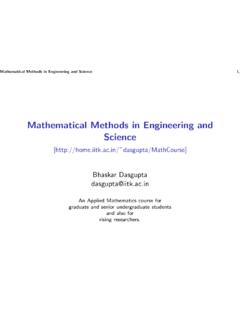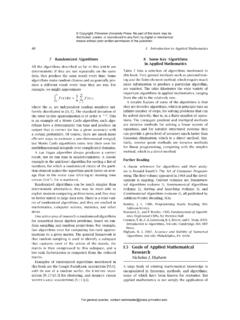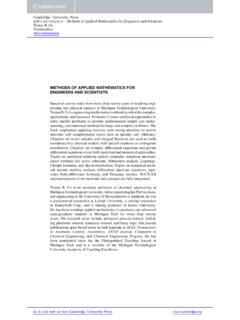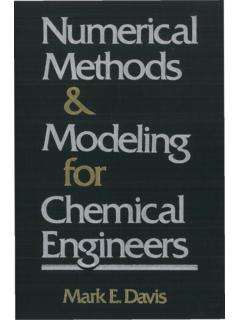Transcription of Applied Mathematics - Brown University
1 Applied Mathematics 1 Applied MathematicsChairBjorn SandstedeAssociate ChairKavita RamananThe Division of Applied Mathematics at Brown University is one ofthe most prominent departments at Brown , and is also one of theoldest and strongest of its type in the country. The Division of AppliedMathematics is a world renowned center of research activity in awide spectrum of traditional and modern Mathematics . It exploresthe connections between Mathematics and its applications at boththe research and educational levels. The principal areas of researchactivities are ordinary, functional, and partial differential equations:stochastic control theory; Applied probability, statistics and stochasticsystems theory; neuroscience and computational molecular biology;numerical analysis and scientific computation; and the mechanics ofsolids, materials science and fluids.
2 The effort in virtually all researchranges from Applied and algorithmic problems to the study of fundamentalmathematical questions. The Division emphasizes Applied mathematicsas a unifying theme. To facilitate cooperation among faculty andstudents, some research programs are partly organized aroundinterdepartmental research centers. These centers facilitate funding andcooperative research in order to maintain the highest level of researchand education in the Division. It is this breadth and the discovery frommutual collaboration which marks the great strength and uniqueness of theDivision of Applied Mathematics at additional information, please visit the department's website: Mathematics ConcentrationRequirementsThe concentration in Applied Mathematics allows students to investigatethe Mathematics of problems arising in the physical, life and socialsciences as well as in engineering.
3 The basic mathematical skills ofApplied Mathematics come from a variety of sources, which depend onthe problems of interest: the theory of ordinary and partial differentialequations, matrix theory, statistical sciences, probability and decisiontheory, risk and insurance analysis, among others. Applied Mathematicsappeals to people with a variety of different interests, ranging from thosewith a desire to obtain a good quantitative background for use in somefuture career, to those who are interested in the basic techniques andapproaches in themselves. The standard concentration leads to eitherthe or degree. Students may also choose to pursue a jointprogram with biology, computer science or economics.
4 The undergraduateconcentration guide is available here ( ).Both the and concentrations in Applied Mathematics requirecertain basic courses to be taken, but beyond this there is a great dealof flexibility as to which areas of application are pursued. Students areencouraged to take courses in Applied Mathematics , Mathematics and oneor more of the application areas in the natural sciences, social sciencesor engineering. Whichever areas are chosen should be studied in program for the 0090& MATH 0100 Introductory Calculus, Part Iand Introductory Calculus, Part IIOr their equivalentProgramTen additional semester courses approved by the Division ofApplied Mathematics . These classes must include: 1 MATH 0180 Intermediate Calculus1 MATH 0520 Linear Algebra 21 APMA 0350& APMA 0360 Applied Ordinary Differential Equationsand Applied Partial Differential EquationsI 32 Select one course on programming from the following: 41 APMA 0090 Introduction to Mathematical ModelingAPMA 0160 Introduction to Scientific ComputingCSCI 0040 Introduction to Scientific Computing andProblem SolvingCSCI 0111 Computing Foundations: DataCSCI 0150 Introduction to Object-OrientedProgramming and Computer ScienceCSCI 0170 Computer Science.
5 An IntegratedIntroductionFive additional courses, of which four should be chosen fromthe 1000-level courses taught by the Division of AppliedMathematics. APMA 1910 cannot be used as an Credits101 Substitution of alternate courses for the specific requirements issubject to approval by the are urged to consider MATH 0540 as an alternativeto MATH 0330, APMA 0340 will sometimes be accepted as substitutesfor APMA 0350, APMA 0360. APMA 1910 cannot be used as are urged to complete their introductory programmingcourse before the end of their sophomore program for the approved semester courses in Mathematics , appliedmathematics, engineering, the natural or social sciences.
6 Theseclasses must include: 1 MATH 0090& MATH 0100 Introductory Calculus, Part Iand Introductory Calculus, Part II2 MATH 0180 Intermediate Calculus1 MATH 0520 Linear Algebra 21 APMA 0350& APMA 0360 Applied Ordinary Differential Equationsand Applied Partial Differential EquationsI 32 Select one senior seminar from the APMA 1930 or APMA 1940series, or an approved one course on programming from the following: 41 APMA 0090 Introduction to Mathematical ModelingAPMA 0160 Introduction to Scientific ComputingCSCI 0040 Introduction to Scientific Computing andProblem SolvingCSCI 0111 Computing Foundations: DataCSCI 0150 Introduction to Object-OrientedProgramming and Computer ScienceCSCI 0170 Computer Science: An IntegratedIntroductionTen additional courses, of which six should be chosed fromthe 1000-level or higher level courses taught by the Divisionof Applied Mathematics .
7 APMA 1910 cannot be used as Credits181 Substitution of alternate courses for the specific requirements issubject to approval by the are urged to consider MATH 0540 as an alternative toMATH Mathematics 12 Applied Mathematics3 APMA 0330, APMA 0340 will sometimes be accepted as substitutesfor APMA 0350, APMA are urged to complete their introductory programmingcourse before the end of their sophomore TracksThe requirements for the professional tracks include all those of each ofthe standard tracks, as well as the following:Students must complete full-time professional experiences doing work thatis related to their concentration programs, totaling 2-6 months, wherebyeach internship must be at least one month in duration in cases wherestudents choose to do more than one internship experience.
8 Such workis normally done at a company, but may also be at a University under thesupervision of a faculty member. Internships that take place between theend of the fall and the start of the spring semesters cannot be used tofulfill this requirement. On completion of each professional experience,the student must write and upload to ASK a reflective essay about theexperience, to be approved by the student's concentration completion of each professional experience, the student mustwrite and upload to ASK a reflective essay about the experience, to beapproved by the student's concentration advisor: Which courses were put to use in your summer's work? Which topics,in particular, were important?
9 In retrospect, which courses should you have taken before embarkingon your summer experience? What are the topics from these coursesthat would have helped you over the summer if you had been morefamiliar with them? Are there topics you should have been familiar with in preparationfor your summer experience, but are not taught at Brown ? What arethese topics? What did you learn from the experience that probably could not havebeen picked up from course work? Is the sort of work you did over the summer something you would liketo continue doing once you graduate? Explain. Would you recommend your summer experience to other Brownstudents? The concentrations in Applied Math (including joint concentrations)require that honors students demonstrate excellence in grades for coursesin the concentration.
10 Students must have earned grades of A or S-with-distinction in at least 70% of the courses used for concentrationcredit, excluding calculus and linear algebra, or be in the upper 20% ofthe student's cohort (as measured by the fraction of grades of A or S-with-distinction among courses used for concentration credit, excludingcalculus and linear algebra). Since S with distinctions do not appear onthe internal academic record or the official transcript, the department willconsult directly with the Registrar s Office to confirm a student s gradesin concentration courses. Additional guidelines and requirements forhonors are published on the department website ( ). Applied Mathematics -BiologyConcentration RequirementsThe Applied Math - Biology concentration recognizes that mathematicsis essential to address many modern biological problems in the postgenomic era.









